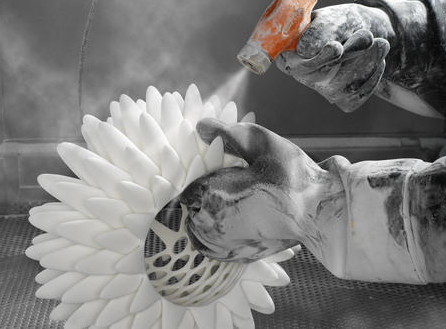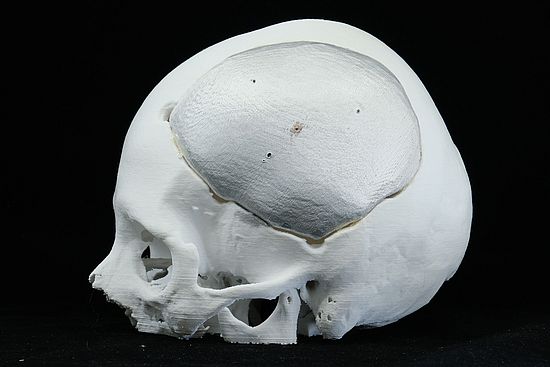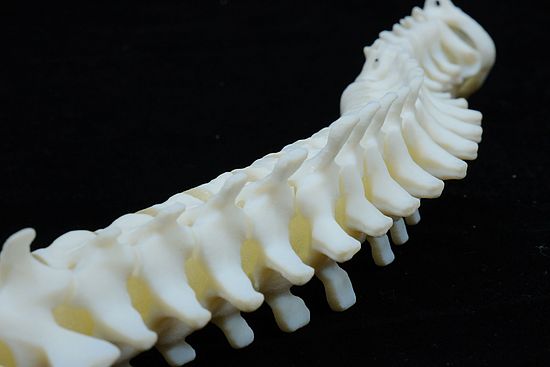PA6 GF Material Details

General Information
PA6 (Polyamide 6) GF20 FR is a widely used material in the industry and has gained popularity in 3D printing due to its impressive properties. This material is reinforced by the addition of 20% glass fibers, resulting in excellent dimensional stability and fracture resistance. It is particularly well-suited for the production of prototypes and functional parts that need to withstand high loads or stresses.
Dimensionally Stable Yet Flexible
The glass fiber reinforcement in PA6 GF20 FR ensures exceptional dimensional stability, while the base material, PA6, provides sufficient flexibility. This leads to an extended elongation at break, meaning that the material can stretch better under load without losing its dimensional stability. This combination of dimensional stability and flexibility makes it ideal for applications where both stability and elasticity are required.
Certified for Aviation Use
Surprisingly, PA6 GF20 FR does not exhibit better abrasion resistance compared to PA12 without fillers. This is because the glass fibers in this material are relatively short, making them more prone to being pulled out of the material. While this results in reduced wear resistance compared to pure PA (Nylon), this drawback is offset by other properties. The "FR" in the material's name stands for "flame-retardant." PA6 GF20 FR has received UL94V0 certification, indicating its suitability for the aviation industry and compliance with stringent fire safety requirements.
This material offers an excellent combination of strength, dimensional stability, and flame resistance, making it particularly appealing for applications in industry, research, and medical technology where safety and durability are paramount.
Printing in PA6 GF
Minimum Wall: 1 mm
Smalest Detail: 0.4 mm
Layer hight: 0.2mm
Max Print size: 256 x 256 x 256 mm
Tollerance: 0.2% min ±0.3 mm
Delivery Times: Typicaly 4-5 Businessdays

Pro`s and Con`s
Pro
- High Strength: PA6 GF20 FR offers remarkable strength, making it ideal for components subjected to high loads.
- Flame Retardant (UL94V0): This material meets strict flame retardancy requirements according to UL94V0, making it suitable for safety-critical applications.
- Aviation Approval: PA6 GF20 FR is approved for aviation, emphasizing its suitability for aerospace industry applications.
- Dimensionally Stable: The glass fiber reinforcement imparts dimensional stability to the material while retaining some flexibility.
- High Heat Resistance: The material maintains its strength and shape at elevated temperatures, making it suitable for applications exposed to increased heat.
- Complies with Industry Standards: PA6 GF20 FR complies with specific industry standards such as [EN 45545-2] for railway applications and [NFPA 130], [ASTM E162], [ASTM E662] for use in rail transit systems.
- Low Resolution with FDM Technology: Thanks to its strength and dimensional stability, PA6 GF20 FR can produce precise and detailed parts with low resolution using FDM technology.
- Chemical Resistance: PA6 GF20 FR exhibits good resistance to various chemicals, enhancing its suitability for applications exposed to chemical environments.
- Low Density: This material has a relatively low density, which can be advantageous for reducing the weight of components without compromising strength.
Con
- Reduced Abrasion Resistance: Despite its robustness, PA6 GF20 FR exhibits reduced abrasion resistance compared to pure PA (Nylon) due to its short glass fibers.
- Challenges with Very Large Parts: With very large parts, challenges like warping may arise due to its significant shrinkage properties.
- Very High Water Absorption (Hygroscopic): PA6 GF20 FR is hygroscopic and can absorb high levels of moisture, which must be considered for certain applications.
- High Material Cost: PA6 GF20 FR can be more expensive compared to some other 3D printing materials, which should be considered when selecting it for a project.
- Processing Challenges: The presence of glass fibers can pose challenges during the 3D printing process, such as nozzle wear or the need for specialized equipment.
Applications of PA6 GF 3D Print



- Flame-Retardant Housings: PA6 GF20 FR is ideal for producing housing components that require flame resistance, such as electrical enclosures or protective casings for electronics.
- Structural Components in Mechanical Engineering: Its high strength and flame-retardant properties make it suitable for critical structural components in machinery and mechanical systems.
- Aerospace Components: PA6 GF20 FR's ability to meet aerospace standards makes it a preferred choice for manufacturing aircraft components that require flame resistance and mechanical stability.
- Machine Parts: This material can be used to create machine parts with a balance of strength and flame resistance, ensuring durability and safety in industrial machinery.
- Automotive Manufacturing: PA6 GF20 FR can find applications in the automotive industry, especially in parts that need to meet flame resistance and safety standards.
These examples showcase the versatility and utility of PA6 GF20 FR in various industries where flame resistance and mechanical strength are crucial requirements.
Technical specifications
General Properties
Property | Test Method | Value |
Density | ISO1183, GB/T1033 | 1.2 g/cm³ at 23°C |
Melting Point | 210°C, 2.16kg | 15.9 g/10min |
Light Transmission | N/A | N/A |
Flame Resistance | N/A | N/A |
Moisture Absorption | 70%RH – 23°C | 3.22% |
Approved for:
- [EN 45545-2] – Railway Applications
- [NFPA 130] ASTM E162, ASTM E662 – Standard for Fixed Guideway Transit and Passenger Rail Systems
- [SMP 800-C] – Smoke and Toxic Gas Generation
Mechanical Properties
Property | Test Method | Value |
Elastic Modulus (X-Y) | ISO 527, GB/T 1040 | 4431 ± 184 MPa |
Elastic Modulus (Z) | ISO 527, GB/T 1040 | 3330 ± 145 MPa |
Tensile Strength (X-Y) | ISO 527, GB/T 1040 | 84.5 ± 2.1 MPa |
Tensile Strength (Z) | ISO 527, GB/T 1040 | 61.4 ± 3.9 MPa |
Elongation at Break (X-Y) | ISO 527, GB/T 1040 | 3.4 ± 0.3% |
Elongation at Break (Z) | ISO 527, GB/T 1040 | 2.9 ± 0.7% |
Flexural Modulus (X-Y) | ISO 178, GB/T 9341 | 4637 ± 293 MPa |
Flexural Modulus (Z) | ISO 178, GB/T 9341 | N/A |
Flexural Strength (X-Y) | ISO 178, GB/T 9341 | 136.4 ± 1.6 MPa |
Flexural Strength (Z) | ISO 178, GB/T 9341 | N/A |
Impact Strength (Charpy X-Y) | ISO 179, GB/T 1043 | 16.5 ± 1.5 kJ/m2 |
Impact Strength (Charpy Z) | ISO 179, GB/T 1043 | N/A |
Thermal Properties
Property | Test Method | Value |
Glass Transition Temperature | DSC, 10°C/min | 70.4 °C |
Melting Temperature | DSC, 10°C/min | 214.5 °C |
Crystallization Temperature | DSC, 10°C/min | 174.5 °C |
Decomposition Temperature | TGA, 20°C/min | >370 °C |
Vicat Softening Temperature | ISO 306, GB/T 1633 | N/A |
Heat Deflection Temperature (1.8MPa) | ISO 75 | 157 °C |
Heat Deflection Temperature (0.45MPa) | ISO 75 | 191 °C |
Thermal Conductivity | N/A | N/A |
Thermal Shrinkage Rate | N/A | N/A |



